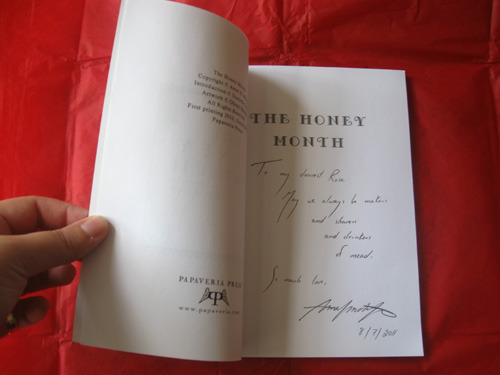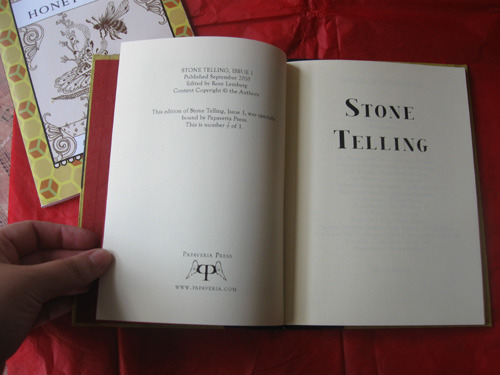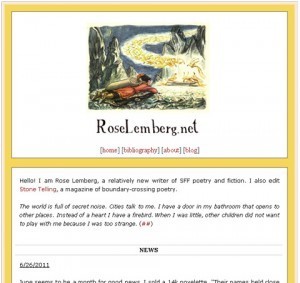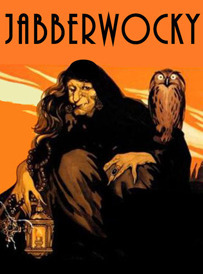R.B. Lemberg's Blog, page 44
August 9, 2011
Harry Potter: the curious case of Ariana Dumbledore
Cat Valente (
![[info]](https://i.gr-assets.com/images/S/compressed.photo.goodreads.com/hostedimages/1380451598i/2033940.gif) yuki_onna
) has an interesting and worthwhile discussion of Dumbledore's decision to let Harry be raised by the Dursleys in Dumbledore's Theory of Early Childhood Education:
yuki_onna
) has an interesting and worthwhile discussion of Dumbledore's decision to let Harry be raised by the Dursleys in Dumbledore's Theory of Early Childhood Education:...this whole plan of Dumbledore's really could have gone very wrong. Because while, yes, it is true that being raised by normal people [...] instead of in a nonstop fame factory MIGHT create a gentle, humble, sweet-natured boy, it could also, quite easily, create a sociopath.
Commenters chimed in on this issue and other things that bothered them about the Harry Potter books. I raised a few points, one of which I would like to make also on my own journal.
I also have a large problem with the way Rowling portrayed the whole Dumbledore/Ariana scenario - not because of what Albus D. says or does (we all [are/were] young and make mistakes), but because I am sick and tired of narratives in which the disabled kid conveniently dies. I say this as a mother of a disabled kid. Why was Ariana denied medical intervention? Why would she have to be taken away to St. Mungos? Why, if her parents chose to homeschool her, wouldn't they receive better support? Why couldn't she (and other magical kids with disabilities, of whom we see... nobody) mainstreamed in the wizarding school?
For those who do not remember what exactly happened: Ariana was a sister of Albus and Aberforth Dumbledore. At the age of six she was accosted and beaten by three Muggle children. Her magic becomes unstable (and 'uncontrollable'). Dumbledore the father, instead of getting his little girl to the hospital pronto, attacks the Muggle kids and goes to Azkaban for it (and dies there). The mother then decides to hide Ariana so that she won't be committed to St. Mungo's. Ariana is raised in secret -even the neighbors are not allowed to know about Ariana's issues - that's why Ariana is only allowed to go out at night. It is unclear if Ariana receives any education. Ariana accidentally kills her mother during one of her tantrums, and is herself eventually (and accidentally) killed in a skirmish between Grindelwald and Albus Dumbledore.
My problems with this scenario are manifold. Here are some of them:
* Why is exposure to the healers at St. Mungo such a horrible prospect for the Dumbledore family? Why cannot Ariana be seen by a magical healer? I myself am not a big believer in "cures", but as I understand it, the family doesn't even try to consult specialists to try to help Ariana. Her injury simply renders her magic 'uncontrollable' (how do they know?)
* The Dumbledore family's decision to isolate and hide Ariana seems frivolous and irresponsible to me without a MUCH longer discussion of what exactly life at St. Mungo's would be like for her. Granted, since Ariana and Albus weren't growing up in the modern world-equivalent, if we are to compare St. Mungo's of that time to "mental" institutions of yesteryear, then committing a child to such an institution could indeed be a horrible prospect. But where is that discussion?
* Ariana's magic is unpredictable and she is prone to difficult, violent tantrums, but she can, as I understand it, speak, walk, and form emotional attachments (at least with Aberforth). Ariana's condition does not seem severe enough for me to warrant such extreme isolation.
* There are quite a few real-life disabilities that render children 'prone to violent tantrums'. The answer to this is not to closet the kid and deny him/her educational opportunities. Many a neurotypical child would throw violent tantrums if closeted in a house for years without companions and denied an opportunity to go out in daytime. (I am not even talking about educational opportunities, because as I said, I do not remember any mention of Ariana being educated at home, rather than simply hidden).
* Why cannot Ariana go to Hogwarts? Does she even receive a letter? How does the wizarding community deal with its children with autism, ADHD, mental health issues, and other disabilities? (Yes, I know it is fiction; but it is fiction that is supposed to reflect reality, as far as I understand).
Ok. What do you think?
August 1, 2011
Boosting the Signal: World SF Travel Fund
![[info]](https://i.gr-assets.com/images/S/compressed.photo.goodreads.com/hostedimages/1380451598i/2033940.gif) charlesatan
), the tireless blogger and reviewer, has been nominated for the World Fantasy Award in the non-professional category.
charlesatan
), the tireless blogger and reviewer, has been nominated for the World Fantasy Award in the non-professional category. The World SF Travel fund has been established to "enable one international person involved in science fiction, fantasy or horror to travel to a major genre event", and if their fundraising drive is successful, the funds will be used to bring Charles over to the World Fantasy Convention, as well as fund someone else's travel next year.
This is a very worthy undertaking. International travel is expensive, and fans working overseas do not have a lot of opportunities to travel to most major genre cons. Yet I believe that fandom is enriched by diverse, international viewpoints; and Charles is doing a lot for fandom. I am sure that the person chosen next year will be equally worthy.
If you are so moved, please consider donating to the fund.
July 29, 2011
Beautiful books from Papaveria Press
This post is about two small gods: Amal El-Mohtar's The Honey Month, and a limited edition hardcover of Stone Telling 1 for Ursula Le Guin.

Two books created by Erzebet YellowBoy of Papaveria Press
1. Amal el-Mohtar's The Honey Month began as an experiment to taste and write about 28 different honeys during the month of February 2010. The entries first appeared in Amal's blog, and then as a book from Papaveria Press:
Each day she uncapped a vial of honey, letting the brew inspire the words that became this book. Amal offers us much more than poetry and prose, however. Her words wrap around us like spiderwebs, gently pulling us into the web she weaves, where honey girls tempt and tease us, where things lost return and sorrow paints the leaves.
Others wrote beautifully about the book; my favorite review/prose poem is probably Dan Campbell.
When the 2011 Rhysling award for the short form was updated earlier this month, Amal's "Peach-Creamed Honey" took first place. There is no way right now to honor speculative poetry chapbooks, but Amal's Rhysling win is very right (in my opinion), because the Honey Month (again, for me) was the biggest speculative poetry event of 2010.
I won a copy of the Honey Month in the Goblin Fruit prize draw, and received it from Amal in the mail. Here's the dedication page:

"May we always be makers and sharers and drinkers of mead" (amen)
The second is an artist's book – an extremely limited edition (of one) of the first issue of Stone Telling, created by Erzebet. It goes off to Ursula Le Guin as soon as I can muster the courage to profane the small god with my lowly scribbles write a dedication.

without a dedication for now
Originally published at RoseLemberg.net. You can comment here or there.
July 28, 2011
1. LJ seems to be back. No, not leaving LJ. It is a polit...
2. Ups and downs and ups and downs with Mati. One thing about childhood is that young children believe that parents are all-mighty and can fix everything. I cannot fix what's wrong with him. But I am also happy that he is making some progress. It will be painful to see so many neurotypical kids around him in the daycare, because he is woefully behind, and it hurts.
3. TJ the tree whisperer has taken care of my trees. This is the amazing magical thing that happened here in the last 2.5 days. First of all, I have a house. I am first in five generations of my family to own a home, probably even longer than that, we do not know. It's been my childhood dream to coexist with trees (I don't quite get in what sense one can 'own' trees, forgive me, English-speaking readers*). My dream came true: on our lot, there are four mature trees and one immature tree. The mature trees have not been trimmed in many, many years and the dead branches were creating a hazard. In comes TJ the tree whisperer. He used to be an arborist at our university, and finally quit after twenty-something years because they've been cutting too many trees.
Yes. That's why he quit.
Did I mention I really like TJ?
I talked to him about my trees last year, and he gave me an estimate; I did not have the money then. He also told me an awful lot about my trees, trees in the area, trees at my university, etc.
I've been saving, so this summer I got a few competing bids from other people. They all wanted less money, but none of them talked about my trees, not even to name them, not even to say how beautiful they are.
Sure enough, I called TJ, and he took care of my trees. Tenderly. That's the right word for it.
He also told me that we have two young redbud trees that started up in the back yard, and in October he'll come back and help me with the back yard and help these newborn redbud trees. I had two volunteer trees there (probably also redbuds) when we bought the house in 2008, and the landscaping guy who came to 'clean up' for the sale just tore them out; he didn't even ask me about it, because he assumed I wanted them out. TJ assumed I wanted these trees to live.
He loves trees. I love trees.
I hope I didn't bore you with this :)
-----------------------------------
* an astute reader PM'd me to ask if I meant to have a footnote about different languages expressing ownership differently. Yes, yes they do, by all means they do. I'll write a fresh entry about this tomorrow, k?
July 20, 2011
Adulthood!
I am a grown-up now. I just had beer for lunch.
Priorities change.
(but to be fair, I also sometimes have ice cream for lunch).
July 11, 2011
Shout-out for Bursts of Light
Says Jamie:
I want to put together a short story anthology of positive speculative fiction. I'd like the chance to create a collection of fantasy and science fiction stories that makes the reader feel better about life, the universe, and everything. I want to see hope overcoming despair, hard work paying off, and the victory of the human spirit. I want to put together a book that can cheer you up when you're having a bad day.
I know Jamie Lackey personally, and I trust her to put together a really great offering. I don't say these things lightly. Jamie has a great eye, is a very attentive reader, and moreover, she understands - and digs - positive speculative fiction. If this appeals to you, I would encourage you to check out her kickstarter. As always with such endeavors, every pledged dollar helps!
July 7, 2011
Mead and Piss
he turned himself into the shape of an eagle and flew as furiously as he could; but when Suttungr [the giant, father of Gunnlöðr] saw the eagle's flight, he too assumed the fashion of an eagle and flew after him. When the Æsir saw Odin flying, straightway they set out their vats in the court; and when Odin came into Ásgard, he spat up the mead into the vats. Nevertheless he came so near to being caught by Suttungr that he sent some mead backwards, and no heed was taken of this: whosoever would might have that, and we call that the poetaster's part. [Snorri, Prose Edda]
I've written a feminist retelling of this from the point of view of the giantess, which was published in GUD 5: I changed the narrative around, but this part is faithful, and I am quoting it here because I can:
I saw him huffing in eagle-shape, lumbering across the sky, feathers a-thunder, rubbing and clapping against each other. And I smelled fear in his sweat, for my father was gaining behind him, a broader eagle, his own shape speedy and slim. “Slay him!” I screeched, and Ill-doer’s eagle looked over his shoulder, shaking, and some of the stolen mead escaped him in a stream of piss. I squinted; down below, on the ground, puny humans were waiting with mouths agape for this yellow rain; hopeless rhymesters to be, bad poets, hangers-on.
My people, we've spent a fair amount of words - good words, powerful words, important words - on the products of that piss. Mike, Amal, Mari, Erik, Shweta, and others raised their wise and passionate voices for what matters to us. Mari, writing about poetry and disability, said this, which strikes me as true and important:
oh god, do we need poetry. We need poetry because the world is full of cracks and broken sidewalks and terrorists and bombs and tsunamis and sudden fires and dead children and really, really awful shit. We need poetry because some people want to turn language into weapons, want to walk the edge of language and violence. We need poetry because the world is full of pain.
My people, we don't need an organization to do that. Below, I will list some people who have been producing amazing work. Links lead to poems.
Amal. Mike. Mari. Shweta. Cat. Erik. Calvin. Athena. Sonya. Lisa. Peer. Elizabeth. Jules. Sam.
Let's refocus on the mead.
July 5, 2011
"A Mother Goes Between" is up
My story "A Mother Goes Between" is up at the new, online incarnation of Jabberwocky (Jabberwocky 6). It is a difficult and triggery story, but one I love very much, and I'm happy that Erzebet and Sean gave it a home. I'd love to hear what you think.
Originally published at RoseLemberg.net. You can comment here or there.
July 1, 2011
All kinds of Jews - and respectful worldbuilding?
The novel is not about the Khana, but they are prominently featured. One of my protagonists is Sureh, a young Khana woman from Niyaz. Relatively to the Coast (my starting-out culture), Niyaz is located in the south.
There are Khana living in many other countries, and those Khana all differ from each other in customs, though perhaps slightly less than real-world Jews differ from each other. There is also, of course, the religious/societal core that makes these communities similar to each other. The Khana women trade across the landmass, and guest with each other, as well as collaborate in trading endeavors.
I don't know if this is interesting? But in case it is...
There is a lot synchronic diversity, there is a lot of historical depth and historical diversity. Throughout their long and complex histories, the world's Jewish communities differed in prestige, affluence, folklore, customs and foodways, trade connections, amount of anti-Semitic violence they experienced, art, etc. They varied and still vary wildly in languages spoken. They differ in looks. Yet, there are significant commonalities in most of these communities. They are Jews, and recognize each other as Jews (for the most part; it is not as straightforward in the case of Beta Israel).
In the US, writers engaging with Jewish themes mostly write about Ashkenazi Jews. The Jews who live here are mostly of Ashkenazi origin, though the first Jewish communities in the States were Sephardi.
Within Ashkenazi communities, there also is diversity. Polack Jews differ from Litvaks from German Jews from ex-Soviets. But, relatively speaking, a much greater diversity exists in non-Ashkenazi communities.
I do no say "Sephardi" for a reason. Not all non-Ashkenazi Jews are Sephardi. Sephardi means Spaniard, and implies that these Jews came from Spain after the exile in 1492. Some non-Ashkenazi Jews have never been through Spain. Another umbrella name for these non-European Jews is Mizrakhi ('Eastern'), although that term also excludes some communities. I've heard many a scholar complain that there is no good word to describe non-Ashkenazi Jews.
I am an Ashkenazi Jew, and an ex-Soviet. In my research, I am engaged with Eastern European Jewish communities, though not necessarily of Ashkenazi extraction; the bulk of my diachronic research in this area involves medieval Romaniotes (non-Ashkenazi Jews of Byzantine extraction). I know a fair amount about other places and times; I know a fair amount about Bukhori Jews, for example, though I myself am not Bukhori.
As you can glean from those Wikipedia entries, there is a LOT, an awful LOT of stuff, and the present-day interactions between different Jewish communities tend to be wrought with complications. The Rabbi's Cat has a good, nuanced treatment of many of these complexities.
There's no way I can stuff all that, or even a sliver of all that, into a YA book which happens in a secondary world, a book which is, moreover, not about the Khana, because is not about any one culture that I present there. Plus, the Khana are not Jews, though they are inspired by Jews.
What kind of Jews were my Khana inspired by? Ah. And here we come to my issues. My Khana were inspired by both Ashkenazi and non-Ashkenazi communities. There is no straightforward mapping to any one community. Mostly my Khana draw on general Jewish features, but specific non-Ashkenazi features are definitely present, as are Ashkenazi features, as are the features I made up. I do know that I would never write a real-world story from a non-Ashkenazi viewpoint; that feels wrong. But the Khana are not Jews, and it's a secondary world. Is that a problem? I honestly don't know.
I spent an hour last night trying to figure out what Sureh will be baking. Not rugalakh, that's for sure.
She's telling me that she's going to bake bird's nests with kodai nuts (real-life equivalent at Mansoura bakery). I'm nervous because I've ever only baked Ashkenazi goods, and have never made these, although I've eaten my share. They are delicious.
June 30, 2011
New website
Originally published at RoseLemberg.net. You can comment here or there.
I've redesigned roselemberg.net! I liked the old yellow version, but it was time to upgrade. 
The new official (gasp) blog/site runs on WordPress, and cross-posts entries to my Livejournal. I am still fiddling with the template, but am pretty happy with it for now. In the future, I am planning a custom logo graphic (custom by me, unless someone volunteers to make me one), more samples in the Samples folder, and perhaps a different navigation bar. Your thoughts and suggestions are welcome.




